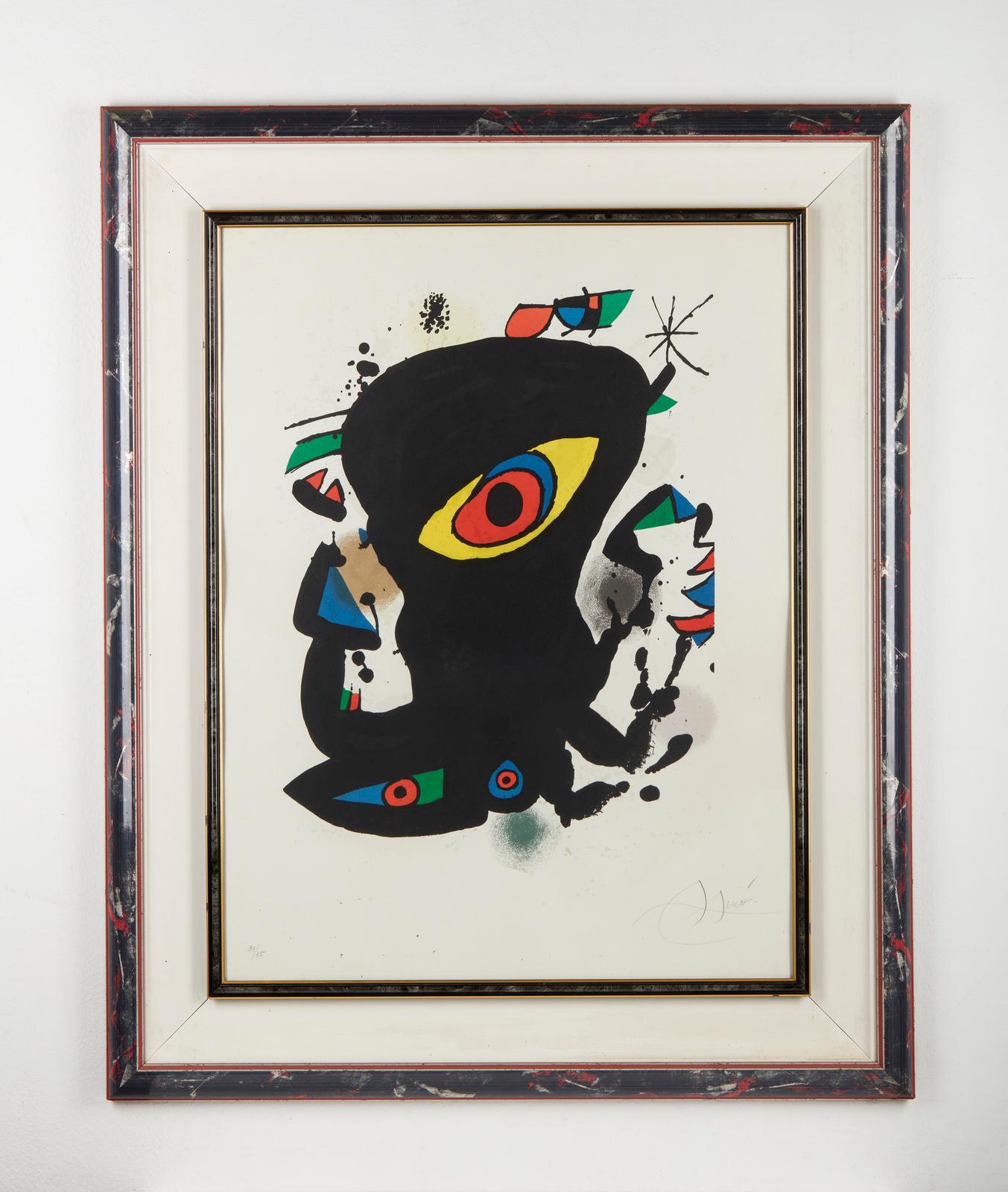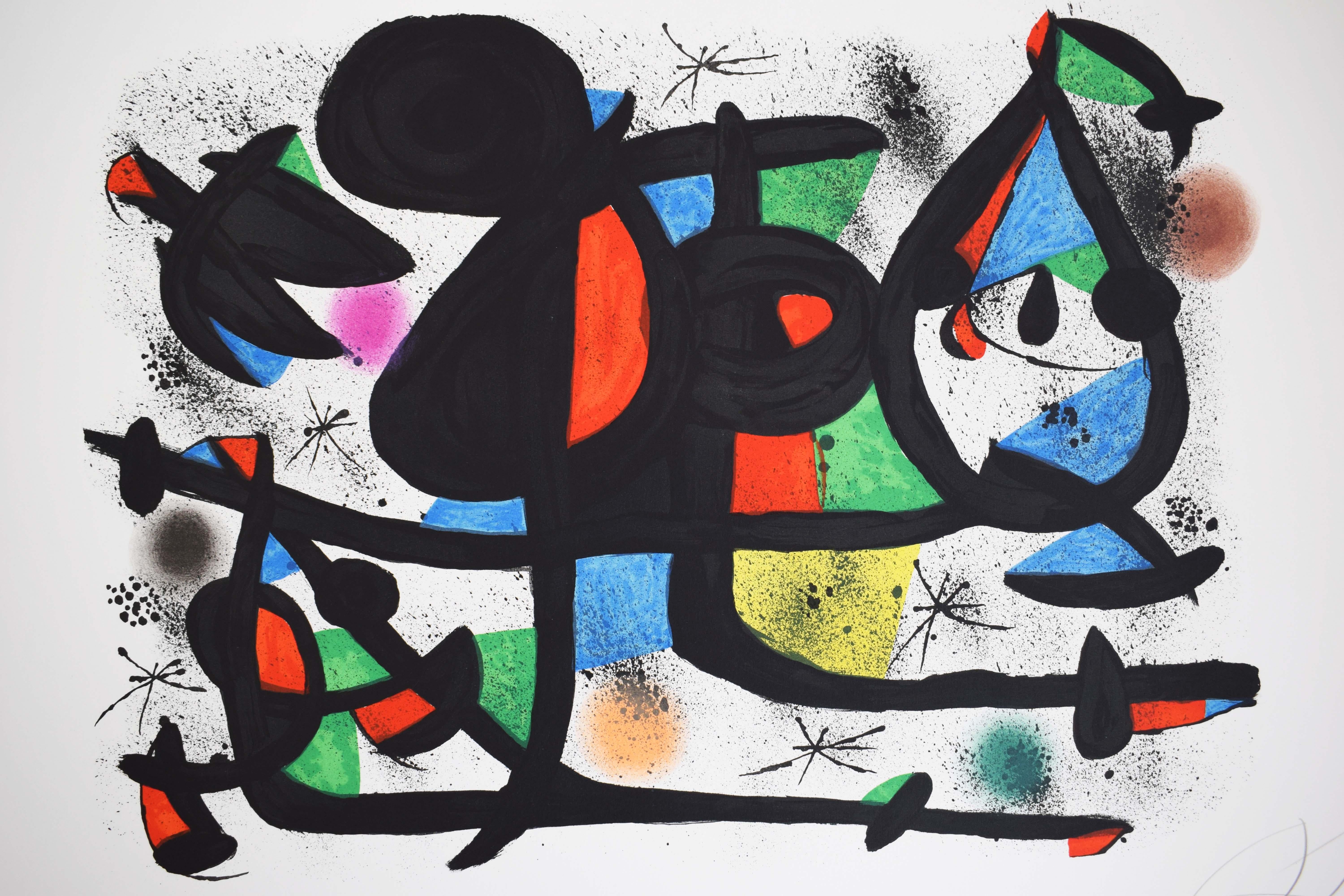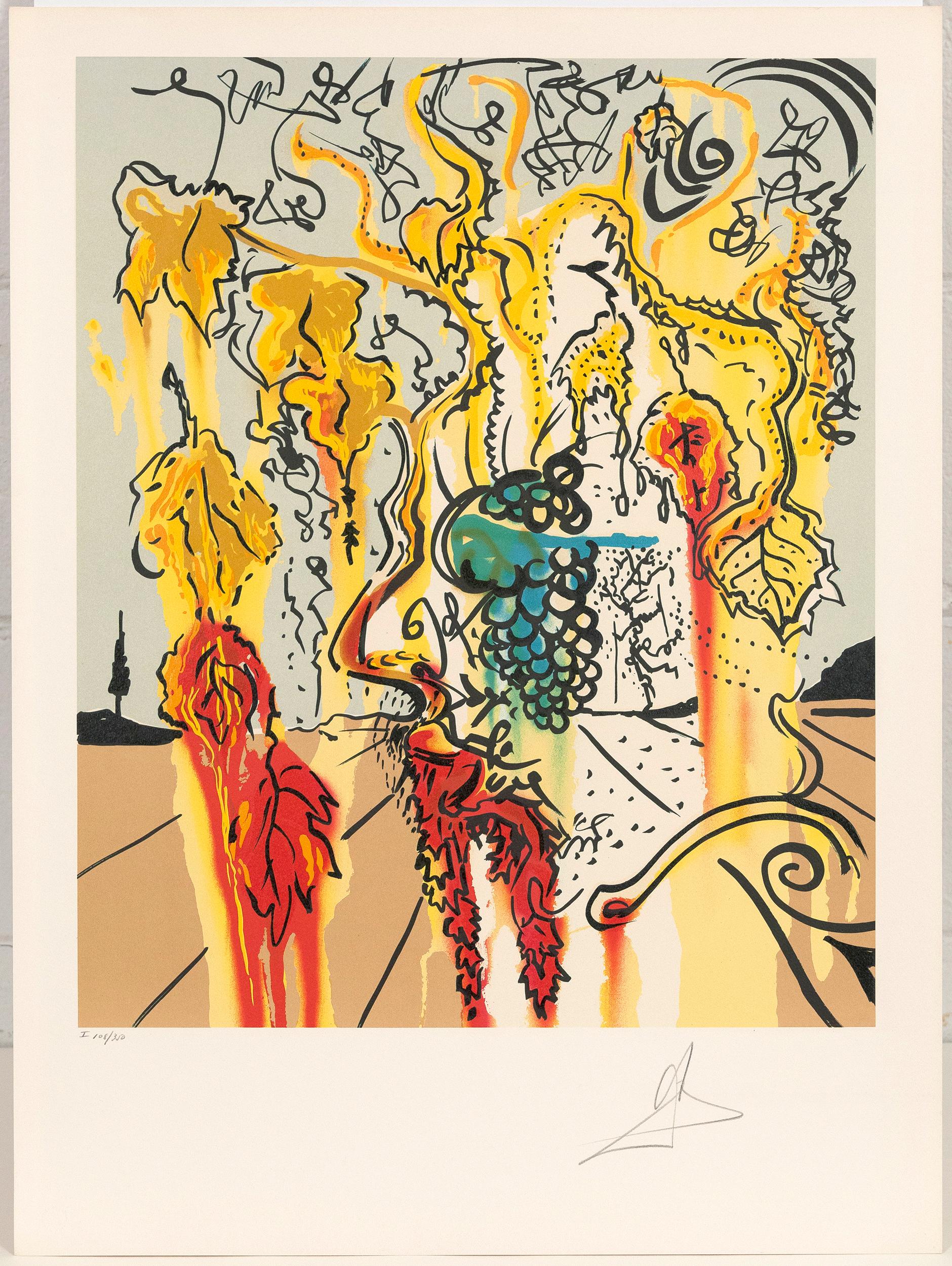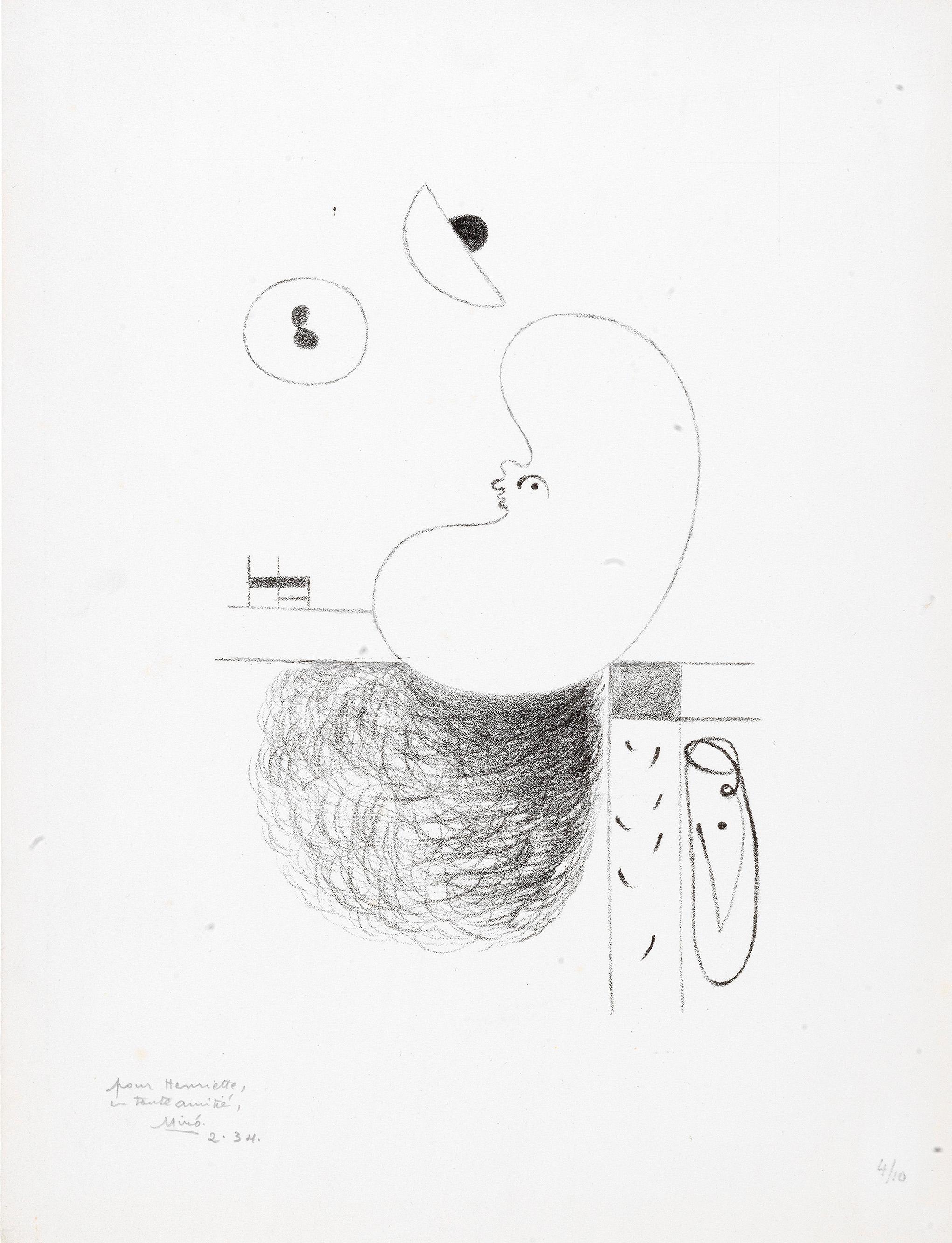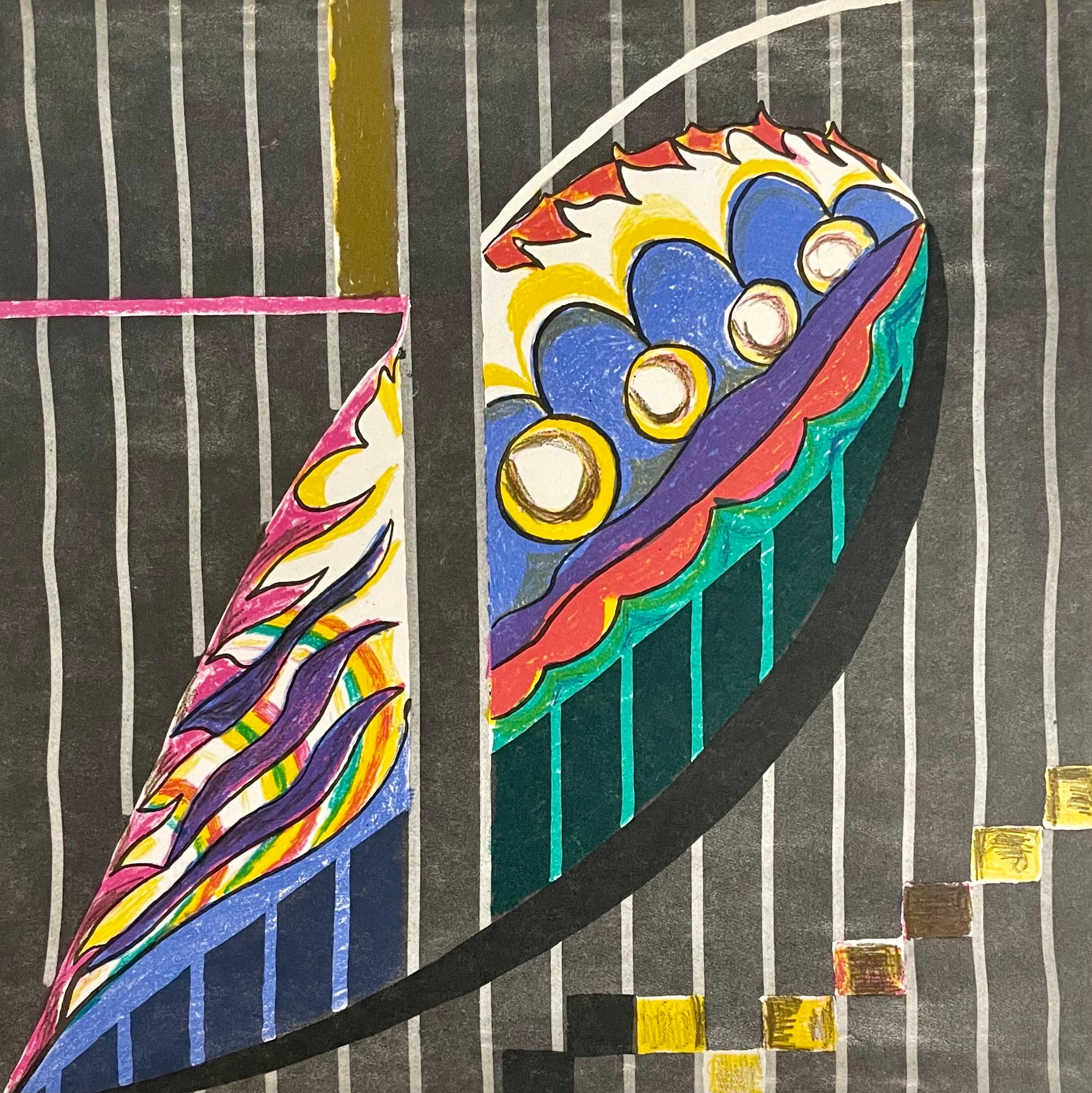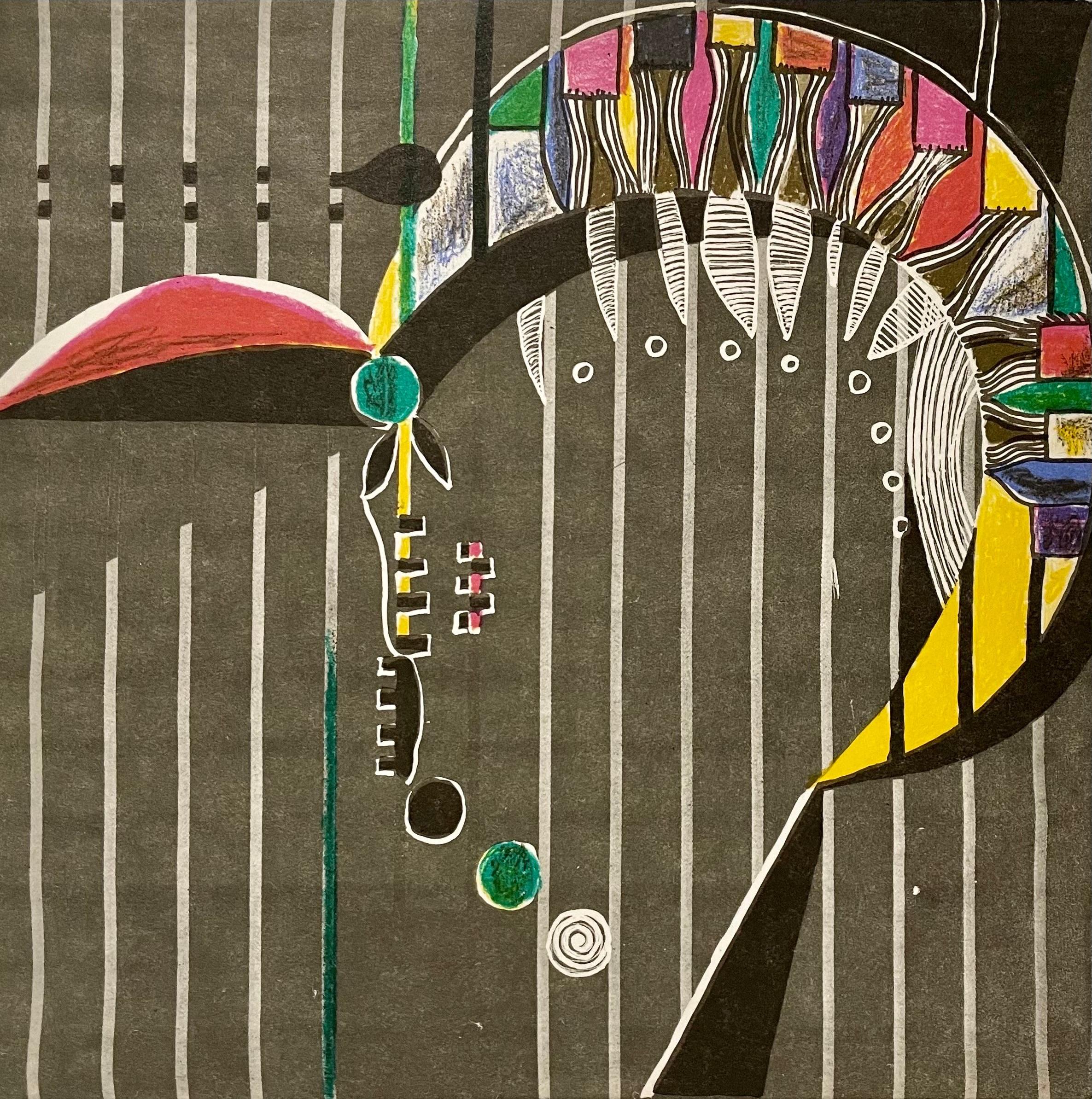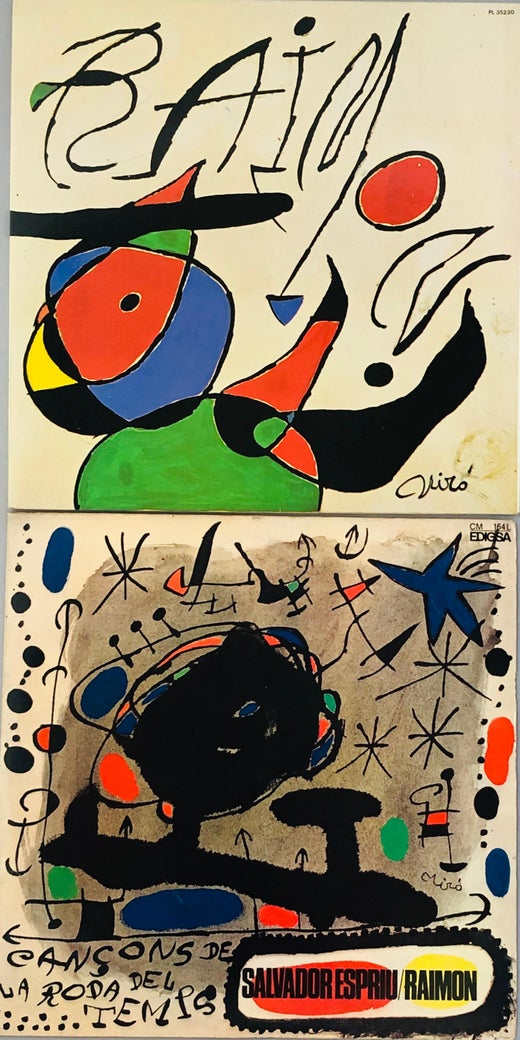Joan MiróLe Lézard aux Plumes d'Or - Lithograph by Joan Miró - 19711971
1971
About the Item
- Creator:Joan Miró (1893 - 1983, Catalan)
- Creation Year:1971
- Dimensions:Height: 13.98 in (35.5 cm)Width: 19.69 in (50 cm)Depth: 0.04 in (1 mm)
- Medium:
- Movement & Style:
- Period:
- Framing:Framing Options Available
- Condition:Insurance may be requested by customers as additional service, contact us for more information.
- Gallery Location:Roma, IT
- Reference Number:
Joan Miró
With his wide-ranging oeuvre, comprising strikingly original paintings, prints, ceramics, sculptures, metal engravings and murals, Catalan modernist Joan Miró was a critical force in moving 20th-century art toward complete abstraction. Although often considered an early Surrealist because of his nonobjective imagery and evocation of the subconscious, he defies neat categorization.
Miró’s identity is largely rooted in the city of his birth: Barcelona. To this day, a number of his public artworks can be found there, including the 72-foot-tall statue Dona i Ocell (Woman and Bird), 1983. Female and avian forms, along with bright colors and the theme of Catalan pride, are recurring elements in his work.
The radical visual world Miró created with his expressive lines, signature symbols and biomorphic shapes influenced such American Abstract Expressionists as Jackson Pollock and Color Field painters like Mark Rothko and Barnett Newman.
Mirò continued to work and experiment until his death at the age of 90 in 1983. Five years before that, he was quoted saying, “I painted these paintings in a frenzy, with real violence so that people will know that I am alive, that I’m breathing, that I still have a few more places to go. I’m heading in new directions.”
Find a collection of original Joan Miró art on 1stDibs.
- ShippingRetrieving quote...Ships From: Rome, Italy
- Return PolicyA return for this item may be initiated within 14 days of delivery.
- Composition - Lithograph by Jean-Pierre Jouffroy - 1963Located in Roma, ITComposition is an Original Lithograph realized by Jean-Pierre Jouffroy in 1963. Good condition on a yellowed paper. Signed, titled and dated by the a...Category
1930s Surrealist Abstract Prints
MaterialsLithograph
- Le Enfe - Lithograph by R.S. Matta - 1970sBy Sebastian MattaLocated in Roma, ITLe enfe, is anArtwork realized by Roberto Sebastián Antonio Matta Echaurren (Santiago, Chile, 1911 - Civitavecchia, Italy, 2002) in 1970. Colored Litograph on paper. Hand Signed on the lower central margin. Edition 6/100. Good conditions. After studying architecture, in 1934 Roberto Sebastian Matta moved to Paris, where he worked with Le Corbusier and came into contact with intellectuals such as Rafael Alberti and Federico García Lorca. Here, he also met André Breton and Salvador Dalí , and adhered to the Surrealist movement, elaborating a painting style focused on psychological morphologies. In 1944, Breton wrote: " Matta is the one who most faithfully keeps his star, which is perhaps on the best path to reach the supreme secret: the control of fire". An extremely dynamic Chilean artist, who met Alvar Aalto in Scandinavia, Henry Moore , Roland Penrose...Category
1970s Surrealist Abstract Prints
MaterialsLithograph
- Mirò Lithographe I - Plate IX - Lithograph - 1972By Joan MiróLocated in Roma, ITMiró Lithographe I - Plate IX is an original artwork realized by Joan Miró in 1972. Lithograph on paper; the hallmark of Graphis Arte, Livorno is on the back. Perfect conditions. This beautiful abstract print comes from the set of...Category
1970s Surrealist Abstract Prints
MaterialsLithograph
- Les Mademoiselles - Lithograph by R.S. Matta - 1970sBy Sebastian MattaLocated in Roma, ITLes Mademoiselles, is an Artwork realized by Roberto Sebastián Antonio Matta Echaurren (Santiago, Chile, 1911 - Civitavecchia, Italy, 2002) Colored Litograph on paper. Hand Signed on the lower right margin. Edition of 283/300. Good conditions. After studying architecture, in 1934 Roberto Sebastian Matta moved to Paris, where he worked with Le Corbusier and came into contact with intellectuals such as Rafael Alberti and Federico García Lorca. Here, he also met André Breton and Salvador Dalí , and adhered to the Surrealist movement, elaborating a painting style focused on psychological morphologies. In 1944, Breton wrote: " Matta is the one who most faithfully keeps his star, which is perhaps on the best path to reach the supreme secret: the control of fire". An extremely dynamic Chilean artist, who met Alvar Aalto in Scandinavia, Henry Moore , Roland Penrose...Category
1970s Surrealist Abstract Prints
MaterialsLithograph
- Personnages - Lithograph by R.S. Matta - 1980sBy Sebastian MattaLocated in Roma, ITPersonnages is an Artwork realized by Roberto Sebastián Antonio Matta Echaurren (Santiago, Chile, 1911 - Civitavecchia, Italy, 2002). Colored Litograph on paper. Hand Signed on the lower right margin. Good conditions. After studying architecture, in 1934 Roberto Sebastian Matta moved to Paris, where he worked with Le Corbusier and came into contact with intellectuals such as Rafael Alberti and Federico García Lorca. Here, he also met André Breton and Salvador Dalí , and adhered to the Surrealist movement, elaborating a painting style focused on psychological morphologies. In 1944, Breton wrote: " Matta is the one who most faithfully keeps his star, which is perhaps on the best path to reach the supreme secret: the control of fire". An extremely dynamic Chilean artist, who met Alvar Aalto in Scandinavia, Henry Moore , Roland Penrose...Category
1970s Surrealist Abstract Prints
MaterialsLithograph
- Miró Lithographe I - Plate X - Lithograph by Joan Mirò - 1972By Joan MiróLocated in Roma, IT"Miró Lithographe I - Plate X" is a vintage lithograph realized by Joan Miró in 1972. Perfect conditions. It comes from the set of 11 lithographs realized for the catalogue "Miró...Category
1970s Surrealist Abstract Prints
MaterialsLithograph
- Joan Miró ( 1893 – 1983 ) - hand-signed Lithograph on Guarro paper – 1974By Joan MiróLocated in Varese, ITcolor lithograph on Guarro paper , edited in 1974 Limited Edition of 75 copies plus 15 HC Hand signed, dated and numbered in pencil 37/75 in pencil (lower left) Paper size: 69,5 x 52...Category
1970s Surrealist Prints and Multiples
MaterialsLithograph
- The Lover’s Sled, from: Allegro Vivace - Spanish Surrealism Musical InspirationBy Joan MiróLocated in London, GBThis original lithograph in colours is hand signed by the artist in pencil 'Miró' at the lower right margin. It is also hand numbered in pencil from the edition of 100, at the lower ...Category
1980s Surrealist Abstract Prints
MaterialsLithograph
- Portrait of AutumnBy Salvador DalíLocated in Toronto, OntarioGlorious, elaborate, and eccentric - these are just a few of the words to describe Salvador Dali (1904-1989). He is Surrealism's most accomplished and iconic practitioner. Prolifi...Category
1980s Surrealist Figurative Prints
MaterialsLithograph
- L'Arbre des voyageurs: III - Joan Miró, Lithograph, SurrealistBy Joan MiróLocated in London, GBFrom Tristan Tzara's 'L'Arbre des voyageurs'. Signed and dated in pencil, a large paper proof. Inscribed 'Pour Henriette, en toute amitié'. Printed on wove paper and published by E...Category
1930s Surrealist Abstract Prints
MaterialsLithograph
- Feminist Surrealist French Abstract Colorful Lithograph Print Myriam Bat YosefLocated in Surfside, FLMyriam Bat-Yosef Surrealist abstract lithograph print in colorful abstract shapes and shades Hand signed and dated 1971. sheet measures 9.25 X 9.25 inches ...Category
1970s Surrealist Abstract Prints
MaterialsLithograph
- Feminist Surrealist French Abstract Colorful Lithograph Print Myriam Bat YosefLocated in Surfside, FLMyriam Bat-Yosef Surrealist abstract lithograph print in colorful abstract shapes and shades Hand signed and dated 1971. sheet measures 9.25 X 9.25 inches The envelope and the Peter Buch poster is just for provenance and is not included in this sale. Myriam Bat-Yosef, whose real name is Marion Hellerman, born on January 31, 1931 in Berlin, Germany to a Jewish family from Lithuania, she is an Israeli-Icelandic artist who paints on papers, paintings, fabrics, objects and human beings for performances. Myriam Bat-Yosef currently lives and works in Paris. In 1933, her family fleeing the Nazi Holocaust, Miriam Bat-Yosef emigrates to Palestine and settles in Jaffa. In 1936, she suffers a family tragedy, her father, militant Zionist, is called to fight, still recovering from an operation of appendicitis. The incision will become infected, antibiotics did not exist yet, and her father will die in the hospital after 9 months of suffering. Myriam and her mother leave Palestine to live in Paris for three years. French is Myriam's first school language. In 1939, still fleeing Nazism, she returned to Palestine, leaving France by the last boat from Marseille. She moved to Tel Aviv with her mother, aunt and maternal grandmother. In 1940, she began attending the Academy of Fine Arts in Tel Aviv and took her name as an artist, Bat-Yosef, which means Joseph's daughter in Hebrew, as a tribute to her father. In 1946, Myriam graduated as a kindergarten teacher but wanted to be an artist. Her mother enrolled her in an evening school to prepare a diploma of art teacher. At 19, she performs two years of military service in Israel. In 1952, with a pension of $50 a month that her mother allocated, she went to study at the Beaux-Arts in Paris. To survive, she has several activities while studying. In 1955, she had her first solo exhibition, at the Israeli Club on Wagram Avenue in Paris. Many artists, such as Yaacov Agam, Yehuda Neiman Avigdor Arikha, Raffi Kaiser, Dani Karavan and sculptors Achiam and Shlomo Selinger attended the opening . In 1956, she enrolled at the School of Fine Arts in Florence. This is where she meets the painter Errô. They share an icy studio in winter. Myriam moves to Milan with friends. She organizes a joint exhibition with Erro, one room each, at the Montenapoleone gallery. Her works are admired by the sculptor Marino Marini and the painters Renato Birolli and Enrico Prampolini. Myriam and Erro exhibit in Rome, Milan, Florence and meet many personalities: Alain Jouffroy and his wife, the painter Manina, Roberto Matta and his wife Malitte, textile artist who was one of the founders of the Pompidou Center. Back in Paris, Myriam and Erro get married, which allows Myriam to avoid being called into the Israeli army during the Suez Canal War. In 1957, Myriam and her husband went to Iceland. Myriam works in a chocolate factory. Having enough money, she starts producing art again. She exhibited in Reykjavik's first art gallery. She meets the artist Sigridur Bjornsdottir, married to the Swiss painter Dieter Roth . In 1958, Myriam and her husband leave for Israel. They exhibit in Germany, then in Israel. Back in Paris, the couple became friends with artists of the surrealist movement, such as Victor Brauner, Hans Bellmer, the sculptor Philippe Hiquily, Liliane Lijn, future wife of Takis and photographer Nathalie Waag. Erro and Myriam have a daughter on March 15, 1960, named Tura, after the painter Cosmè Tura, but also close to the Icelandic Thora or the Hebrew Torah. Bat-Yosef’s complex trajectory throughout the 20th century is linked as much to the transnational history of what was for a time called the School of Paris as it is to a certain legacy of Surrealism. Her work features the same idea of resolving antinomies that also defined the spirit of surrealism, and is enhanced with her readings of the Kabbalah and her spiritual grounding in Taoism. However, while there are reasons for her approach to be associated with the process of the ready-made, it is important to consider the immediate intrication of these works with her practice of performance, during which the body itself is also painted – a feminist response to Yves Klein’s Anthropometries (1960) and an echo of the happenings which Jean-Jacques Lebel organised at the time in Paris. In 1963, Erró told Myriam that if she wants to be a painter, she can not be his wife. Myriam chose to be a painter and the couple divorced in 1964. Since that time, Myriam Bat-Yosef has exhibited in many countries: Europe, United States, Japan, etc. Although long in the shadows, the work of Myriam Bat-Yosef has been greeted by many artists and personalities: Anaïs Nin, Nancy Huston, André Pieyre of Mandiargues, José Pierre, René de Solier , Jacques Lacarrière, Alain Bosquet, Pierre Restany, Sarane Alexandrian and Surrealist André Breton who, after a visit to her studio, confided to having been intrigued by its phantasmagorical dimension. She was included in the book Pop Art and Beyond: Gender, Race, and Class in the Global Sixties by Mona Hadler and Kalliopi Minioudaki. Extract "World Citizen, Artist of the Pop Era Sarah Wilson; Why do we know so little of Myriam Bat-Yosef, the most important female Israeli artist of the Pop era? Issues of identity and sexuality feature constantly in her work. She exhibited internationally from Reykjavik to Tokyo; she had two shows at Arturo Schwarz’s famous Dada/surrealist gallery in Milan; she participated in feminist art events in Los Angeles. Above all, in 1971, she conceived Total Art, a Pop Gesamtkunstwerk inside and outside the Israel Museum, Jerusalem. Painter, performer, and installation artist, she was also a lover, wife, and mother. Of Lithuanian-Jewish descent, she was close to the family of philosopher Emmanuel Levinas. An émigré in Paris she would repudiate a national passport, participating in Garry Davis’s short-lived “World Citizens” movement. She continues the lineage of women surrealist artists: Valentine Hugo, Leonor Fini, Dorothea Tanning, Leonora Carrington, Unica Zürn, Jane Graverol, Toyen, Alice Rahon...Category
1970s Surrealist Abstract Prints
MaterialsLithograph
